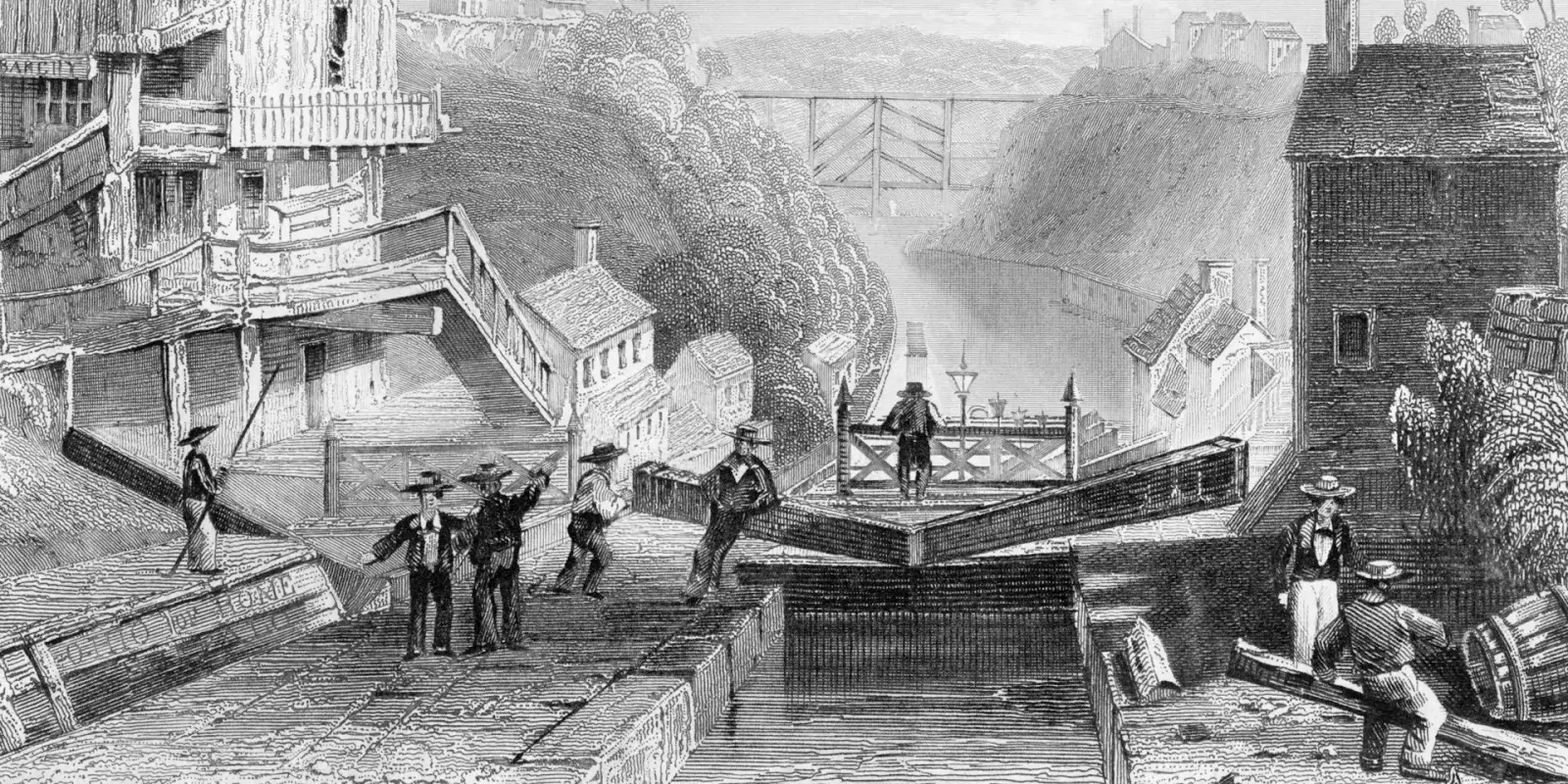
The Story of the Erie Canal
By Noah Howard
As we celebrate the 200-year Bicentennial of the Erie Canal’s opening in 1825, it stands as one of the most transformative infrastructure projects in American history. Conceived in the early 19th century, it reshaped commerce, migration, and industry in New York State and beyond. Often referred to as “Clinton’s Big Ditch,” the canal was initially met with skepticism but ultimately proved its worth by revolutionizing transportation and solidifying New York’s place as a commercial powerhouse.
DeWitt Clinton’s Vision and the Birth of the Erie Canal
New York’s Governor DeWitt Clinton was the driving force behind the Erie Canal. A staunch advocate for internal improvements, Clinton recognized the economic potential of linking the Atlantic Ocean to the Great Lakes. Before the canal’s construction, transporting goods across New York was costly and time-consuming, often requiring weeks of travel by wagon. Clinton envisioned a waterway that would cut transportation costs, encourage westward expansion, and promote trade.
Despite his enthusiasm, Governor Clinton faced harsh criticism. Many political opponents and skeptical citizens ridiculed the idea, calling it “Clinton’s Big Ditch”, -a derisive term meant to mock the grandiosity of the project. Detractors argued that the plan was too ambitious, too costly, and destined to fail. Nevertheless, Clinton remained undeterred, securing funding through state bonds after the federal government declined support. In 1817, construction began, and after eight years of arduous labor, the canal opened in 1825.
Engineering Marvel and Economic Boom
The Erie Canal stretched 363 miles from Albany to Buffalo, featuring a series of locks, aqueducts, and embankments that overcame varied topography. It was an engineering marvel of its time, requiring innovative solutions to carve a water route through upstate New York’s forests, hills, and swamps.
Once completed, the canal exceeded all expectations. Freight costs dropped by as much as 95%, and the time required to transport goods from the Midwest to the East Coast was slashed dramatically. Cities along the canal—Rochester, Syracuse, and Buffalo—grew rapidly, fueled by an influx of commerce and settlers. New York City, benefiting from increased trade, quickly became the nation’s premier port.
The Erie Canal in Cayuga County
Cayuga County played an integral role in the Erie Canal’s success. The canal’s route passed through the northern part of the county, bringing economic opportunities to towns and villages such as Weedsport, Port Byron, and Montezuma. These communities flourished as canal-side trade hubs, with local businesses catering to the needs of travelers and merchants moving goods through the waterway. The village of Montezuma, in particular, became a vital location due to its proximity to the Montezuma Marsh, where early canal builders faced significant challenges in stabilizing the waterway.
The canal also provided the region’s farmers with an efficient means to transport their produce to larger markets, creating new economic possibilities and fostering agricultural growth in the region. Carrying a continuous stream of essential goods from Cayuga County, barges laden with flour, potash, pork, whiskey, lumber, and wool helped transform upstate New York into a dynamic center of trade and commerce, fueling the nation’s growth.
Connection to the Cayuga-Seneca Canal
Completed seven years prior in 1818, the Cayuga-Seneca Canal was an important addition to the Erie Canal system. This waterway connected Cayuga and Seneca, the two largest Finger Lakes, expanding the canal’s influence and integrating local industries into a growing trade network along nearly 200 miles of shoreline. The Cayuga-Seneca Canal facilitated the transportation of agricultural goods, lumber, and manufactured products, further boosting the region’s economic development and integrating Finger Lakes commerce into the broader canal system.

Evolution into the Barge Canal
The Erie Canal did not remain static. As transportation technology advanced and commerce demands grew, the original canal underwent multiple enlargements. By the early 20th century, the state modernized the waterway into what became known as the New York State Barge Canal. Completed in 1918, the Barge Canal widened and deepened the existing Erie Canal, allowing for the passage of larger vessels and mechanized shipping, further cementing its place in the state’s transportation network.
A Lasting Legacy
Once dismissed as the ridiculed “Big Ditch,” the Erie Canal became one of the most transformative public works projects in American history. Governor DeWitt Clinton’s steadfast dedication not only reshaped New York’s economy but also silenced the skeptics. Today, while its commercial significance has waned with the rise of the railroad and highway network, the Erie Canal remains a treasured historical landmark, celebrated for its role in shaping the nation’s growth. Cayuga County’s connection to this monumental project serves as a reminder of the profound impact the canal had on small communities, opening doors to commerce, transportation, and prosperity that still resonate today.
Click here learn more about the Cayuga County Villages along the Erie Canal.